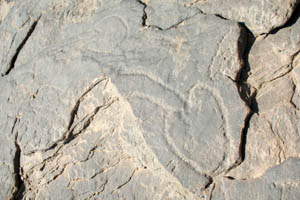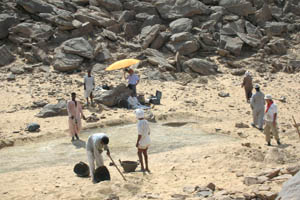|
In the deserts on either side of the River
Nile petroglyphs of all periods can be found. The hills just southeast of
modern El-Hosh (between Edfu and Aswan) preserve some Predynastic depictions
of giraffes, but also these much earlier drawings of fish traps:
|
|
When, by change, a well preserved, high status
burial of the Naqada II (Gerzean) period (ca. 3500-3200 BCE) was
discovered in a valley between two of the hills southeast of El-Hosh, it
was decided to survey and excavate the area to better understand this grave
field:
|
|
|
|
|

|
|

|
|
|
|
|
|
|
|
|
Objective of visit:
|
|
To survey and excavate
a narrow valley just southeast of El-Hosh in order to locate and study more
graves of the Naqada II period. |
|
Date of visit:
|
|
October/November 2005 |
|
Fellow visitors:
|
|
A small team of archaeologists
directed by Dr. Dirk Huyge of the Royal Museums of Art and History in
Brussels (Belgium), funded by the Belgium Ministry of Science Policy. |
| Results: |
|
Apart from a disturbed Middle Kingdom burial, no additional Predynastic graves
were found. Several oval to circular depressions in the bedrock underlying
the sand may be the scars of such graves which have been eroded away. |
| Approximate position and date of the site: |
|
The ancient site of El-Hosh
is located just west of the Nile Valley between Aswan and Edfu which,
in that region, is very narrow. The sandstone hills preserve petroglyphs
of both Predynastic and early Dynastic dates, while between the boulders
on the desert floor a Naqada II and a Middle Kingdom (ca. 1975-1640
BCE) burial have been found. Other petroglyphs and several ephemeral structures
in the area appear to be of later date. |
| Short description of the site: |
|
The sandstone hills southwest
of El-Hosh are surrounded by valleys filled with 0.5-1.0 m. of fine sand.
This appears to have been replaced several times since antiquity, taking
with it all ancient remains. The exception seems to be a few small areas
protected by large boulders in which two ancient graves were unearthed. Most
of the well executed petroglyphs in the region appear rather well preserved.
These were published in D. Huyge (1998), 'Hilltops, Silts and Petroglyphs.
The Fish Hunters of El-Hosh (Upper Egypt),' Bulletin des Musées royaux d'Art et d'Histoire 69: pp. 97-113; and D. Huyge, A. Watchman, M. de Dapper and E. Marchi
(2001), 'Dating Egypt's Oldest Art. AMS 14C
Age Determinations of Rock Varnishes Covering Petroglyphs at El-Hosh (Upper
Egypt). Antiquity 75: pp. 68-72. |
| Additional remarks: |
|
My participation in this
project would not have been possible without the support of the Fayum Project, the Cotsen Institute of Archaeology
and many individuals. |
| HOME |
|
|

|
|
|

